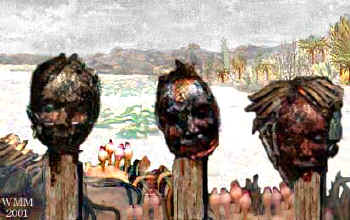
Heart of Darkness: The Inner Station,
by William Max Miller © 2001
Heart of Darkness
Joseph
Conrad's Heart of Darkness explores the human failure to live up to
ideals and the disturbing potential for evil that often overwhelms even the most
noble intentions. No short synopsis can ever hope to do justice to the intricate
plot, lush symbolism, and hypnotic imagery of this tale, but the following
outline will help explain the setting which inspired the painting above.
Set in the Congo during the last years of the 19'th
century, the story relates the experiences of Charles Marlow, who was hired on
as a steam boat captain for one of the European trading companies which at that
time were operating along the Congo river. The Congo had become a territory much
coveted by many European powers, who concealed their rapacious intentions
behind the pretenses of wishing to civilize and enlighten the "poor
savages." Marlow's job is to reach the Inner Station in
order to bring relief to its manager, Mr. Kurtz, a man who, unlike the other
ivory hunters working in the jungle, had a reputation for
carrying high humanitarian ideals into the midst of a brutally exploited
wilderness. As Marlow journeys farther up the river, he grows more disgusted
with his companions from the Central Station, who only think about ivory,
company profits, and petty schemes to curry favor with the company's
heads back in Brussels. The conditions which these men impose upon the Africans
are appalling, and their greed and cruelty cast a shadow of darkness upon the
land. Marlow begins to look forward to talking with Kurtz, who has been
described to him as being altogether different from these average company
men.
After a long trip up the Congo, Marlow finally arrives at the
Inner Station, the province of the long-anticipated Mr. Kurtz. But conditions
there are not what Marlow expected. Kurtz, the humanitarian emissary of Light,
has given way completely to his dark desires and gives them full expression in
the non-restraining freedom of the jungle. He has made himself the ruler of the
local people, who worship him like a god and conduct barbaric ceremonies in his
honor. Marlow begins to discover just how far Kurtz has fallen when he studies
the station house through binoculars from the riverbank:
There were no signs of life, but there were the ruined roof, the long mud wall peeping above the grass, with three little square window-holes no two of the same size, all brought within reach of my hand, as it were. And then I made a brusque movement and one of the remaining posts of that vanished fence leaped up in the field of my glass. You remember I told you I had been struck at the distance by certain attempts at ornamentation, rather remarkable in the ruinous aspect of the place. Now I had suddenly a nearer view and its first result was to make me throw my head back as if before a blow. Then I went carefully from post to post with my glass, and I saw my mistake. These round knobs were not ornamental but symbolic; they were expressive and puzzling, striking and disturbing--food for thought and also for vultures if there had been any looking down from the sky; but at all events for such ants as were industrious enough to ascend the pole....I returned deliberately to the first I had seen--and there it was black, dried, sunken with closed eyelids--a head that seemed to sleep at the top of that pole, and with the shrunken dry lips showing a narrow white line of the teeth, was smiling too, smiling continuously at some endless and jocose dream of that eternal slumber.
Marlow is informed that the heads were those of "rebels," i.e. men who had probably not gone along with every whim of the debased Kurtz. "Those rebellious heads looked very subdued to me on their sticks," comments Marlow. My painting takes three of these heads for its subject. Like Conrad's tale, it serves as a grim indictment of imperialistic exploitation, and also as a reminder of the heart of darkness that still beats within us all.
Read
Heart of Darkness
This is a excellent site which supplies the
complete
text of this remarkable work along with lots of
valuable data about themes, symbolism, etc.
Learn
About The Congo
Provides historical data about the exploitation of
African people. This is the Congo through which
Conrad traveled.
Return
to
The Seventh Tower